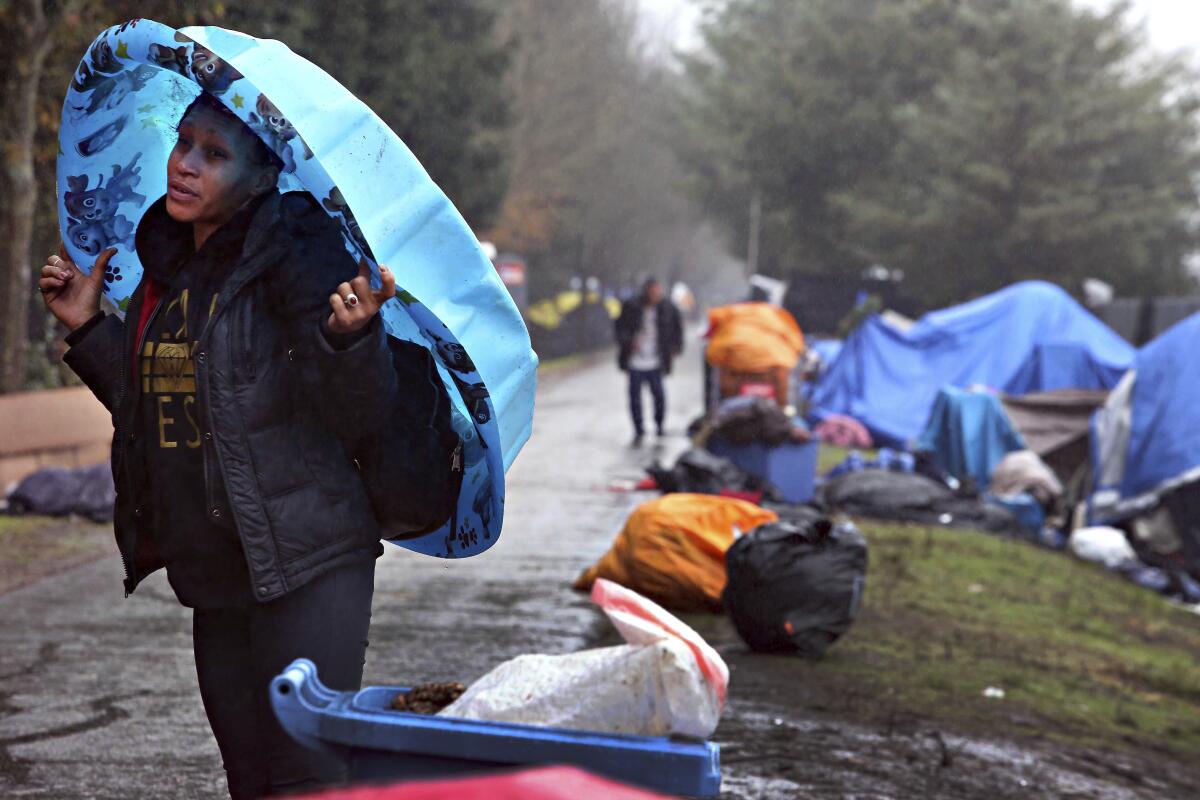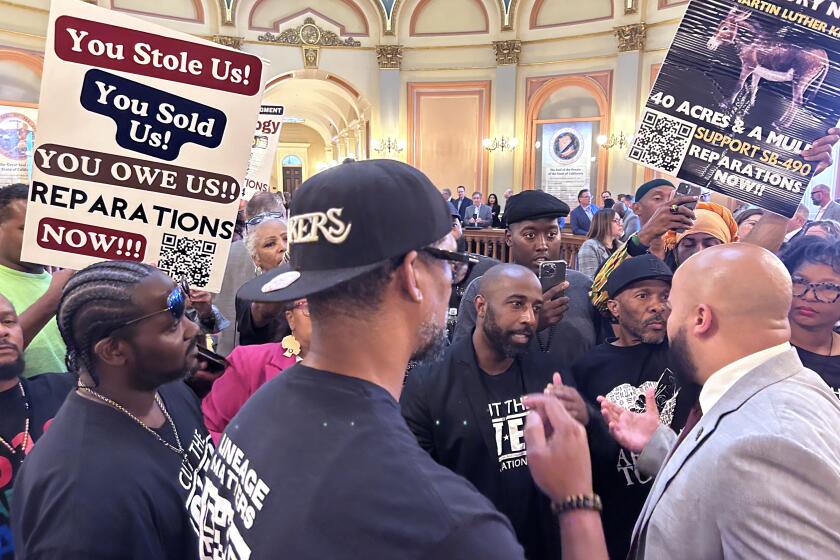Column: Newsom and mayors meet to discuss homelessness. Have we hit rock bottom?

- Share via
Last week, Gov. Gavin Newsom announced that he was rejecting the homelessness action plans of every local government and nonprofit that submitted them, demanding more ambition when it comes to moving people off streets and into homes.
Friday, local elected leaders from across the state, many angry with Newsom’s unexpected and unilateral action, will meet with the man himself in Sacramento to hash out exactly what this means, and what it will take for them to receive the hundreds of millions in funding that Newsom is now holding up.
It’s going to be tense. But sometimes, as the saying goes, you’ve got to break some eggs. There’s deep dysfunction in how we are handling homelessness in California, and it’s to Newsom’s credit that he’s willing to talk about it, because the first step to recovery is admitting you have a problem.
“We’re demoralized by our own lack of performance,” Newsom told me the day before rejecting the plans. “Deliver damn results.”
Get the latest from Anita Chabria
Commentary from the Times' California columnist
You may occasionally receive promotional content from the Los Angeles Times.
Part of that downward spiral is because, when we began giving out massive grants to combat homelessness, we left the majority of decisions in the hands of large cities, counties and “continuums of care” (regional consortiums of governments and service providers) to spend as they saw fit.
In some places, that’s working. In some places, it’s really, really not. We have a system of the good, the bad and the inept.
Though few local officials want to point fingers, it’s an open secret that some politicians have little interest in taking on the hard and often unpopular work of solving homelessness. So they don’t — giving a smattering of truth to the conspiracy theory that the homeless people we see in progressive cities such as Los Angeles, San Francisco and Sacramento aren’t from those places.
Most are, but some have shifted from parts of the Golden State where enforcement and a lack of services are the answer to poverty and misery. That is unsustainable and unfair.
“If there is any belief that the governor’s frustration is [greater] than mayors’, that would be incorrect,” Todd Gloria, the mayor of San Diego, told me. “We are all being lumped together, but there are very significant differences.”
When Gloria heard San Diego’s plan had been rejected, he was driving to a community meeting to explain to unhappy constituents why he was backing the construction of a seven-story, 54-unit building on a lot that formerly held a single-story structure. He ran on a housing platform, and the development is part of a streamlined process that waives fees and some environmental reviews to get affordable housing constructed faster.
But he knows that no matter how much or how fast his city reacts to the linked crises of housing and homelessness, success is “dependent upon other jurisdictions that don’t share San Diego’s opinion that more housing is good for everybody.”
So he gets why Newsom did the blanket reject — an attention-grabbing maneuver that conveys a level of seriousness, even if it unfairly sweeps up the good guys.
But it still stings, because Gloria, like many elected officials and service providers I spoke with, also knows that the bigger hot mess is the often-colliding systems run by the state and federal governments. Those bureaucracies are fragmented, byzantine and the ultimate sources of much of the chaos, hindering the good players while providing cover for the bad.
The whole situation is a bit like alcoholic parents yelling at their kids for being disorganized. This is the piece of the problem Newsom hasn’t acknowledged.
For homeless people who touch that convoluted mash-up of state and federal aid, help involves braiding together dozens of services and providers. Each of those programs has its own rules, its own staff and often goals that don’t align with others on the same case. No one really understands all of it.
On a recent call with state agencies and providers, one woman gave an example: She had found housing for a client and found payment for that housing from another source. But in the end, she needed $35 for the application fee, and she couldn’t find a program to cover it.
Most egregious in that dysfunction is that, too often, cities and their counties aren’t working together.
That is a disaster because the money for social services such as mental health care goes to counties, while the money for shelters and housing often goes to the big cities. When the two don’t cooperate, people remain stuck on our sidewalks in a heartbreaking breakdown that wastes money and lives.
There has been little Newsom or anyone else could do to force partnership between cities and counties except ask nicely. And the way the funding was originally set up — with a final payment tied to hitting self-set goals — led some agencies to aim low in order to maximize their payouts.
The meeting Friday is about a billion dollars in funding known as round three of the Homeless Housing, Assistance and Prevention Grant Program for the policy nerds among you. Newsom wants strings attached to that money now — though he doesn’t really have the legal power to do it, except by futzing with these action plans.
Specifically, Newsom wants cities and counties to commit to signing formal agreements with each other, laying out how they will play nice.
He’s also asking for more streamlining in zoning to combat the rampant NIMBYism that prevents more shelters and interim housing, and that some elected leaders kowtow to on a regular basis.
Those are such basic bits of good governance by the state that it is embarrassing and unacceptable that they haven’t happened sooner.
But it’s not enough.
Both are also obvious places where we need greater state authority. It is unconvincing that Newsom’s one-shot intercession will have lasting effect — or that it involves enough time spent looking in the mirror.
Newsom told me he’s ready to be the “mayor of California” if that’s what it takes to get results. It is.
Our current system is not only dysfunctional, but unmoored, with each jurisdiction pursuing siloed plans that lack cohesive strategy or oversight. It is not working for the state as a whole.
State Assemblymember Reggie Jones-Sawyer, whose newly redrawn district includes L.A.’s skid row, thinks we may need a statewide homeless czar who has the big picture, and the authority, to both help local governments and hold them accountable in the long term.
“I believe in local control, but when local doesn’t take control and get things done, that’s when the state of California really needs to get involved,” Jones-Sawyer told me.
Right now, he said, “There is really no one entity in charge.”
On top of that, most of the money we are spending on homelessness are one-time funds, meaning they will stop flowing in a few years. Jones-Sawyer, Gloria and nearly every other person I spoke with said that, without a commitment of ongoing money, our efforts won’t pay off. It’s like “putting a Band-Aid on a gunshot wound,” Jones-Sawyer said.
But a downturn is here, and recession is threatening. Wednesday, state analysts predicted a $25-billion deficit for next fiscal year, making permanent funding politically unpopular and raising the stakes for delivering with the money that’s already in the pipeline.
Darrell Steinberg, the mayor of Sacramento and former leader of the state Senate, said that’s all the more reason to rethink the whole framework and increase our ambitions in smart and moral ways that are about more than cleaning up streets.
He would like to see a state legal obligation ensuring a right to treatment for our most seriously mentally ill residents. Steinberg points out that we have a legal obligation in California to provide support and services to those with developmental disabilities, all in a community setting that allows recipients to get treatment and help in the homes of their choice.
Steinberg wants a similar legal obligation for those with serious mental illness, conditions that also require lifelong treatment and care — and that, ignored, lead to some of our most tragic and difficult instances of homelessness. After fighting for years on the state and local levels, he’s learned nothing gets done that doesn’t have to be done.
“We talk a lot about leadership and individual leadership,” Steinberg told me this week. “This is about systems, and systems respond to what is required, not what is voluntary.”
Which, really, is how we wound up with Friday’s meeting to begin with.
The final requirement Newsom is demanding is better use of federal housing vouchers. Currently there are more than 46,000 that have been issued but remain unused in the state.
But those vouchers are where the flaws in Newsom’s reset become most apparent.
On the surface, it’s a no-brainer that the thousands of folks with rental vouchers should be helped to find an apartment as quickly as possible. But why it’s not possible goes to the heart of why we aren’t seeing the change we want.
The fundamental problem in California is that for every one person we help into permanent housing, two others lose that security. In some places, that ratio is worse.
As astounding as that 2-1 number is, I checked it with Dr. Margot Kushel, a professor at the Division of General Internal Medicine at Zuckerberg San Francisco General Hospital and Trauma Center. She is also director of the UC San Francisco Center for Vulnerable Populations and the Benioff Homelessness and Housing Initiative. Those are very long titles that mean Kushel knows what she’s talking about.
“This problem is not 160,000 people who need to be housed,” she told me.
It’s that California has a never-ending waterfall of people tumbling over the cliff into a system that is already flooded. No matter how much we spend, how hard we try or how much we accomplish, it’s not enough — it wasn’t even before the pandemic.
We are a million units short on affordable housing, and for every 100 low-income renter households in California, there are only 69 places available they could afford. For the extremely poor, there are 23 units available for every 100 households that need one.
We have systemic, societal problems that have been decades in the making, but that are, in this vulnerable moment, pushing people onto our streets faster than we can get them off.
California, and Newsom, have in recent years become far more aggressive on tackling those underlying issues — in particular cracking down on places that refuse to build their fair share of housing and addressing serious mental illness with a new system of court-monitored treatment that will force counties to provide more care.
But problems that took years to make take years to solve.
Newsom is right to demand local players do better with what they have, to be more ambitious in the midst of a crisis. But those local elected leaders are also right that this is well beyond their ability to fix.
And that’s the hard part about Friday. In some ways, it represents our rock bottom — a sobering intervention where no one should be spared from accountability.
More to Read
Get the latest from Anita Chabria
Commentary from the Times' California columnist
You may occasionally receive promotional content from the Los Angeles Times.











